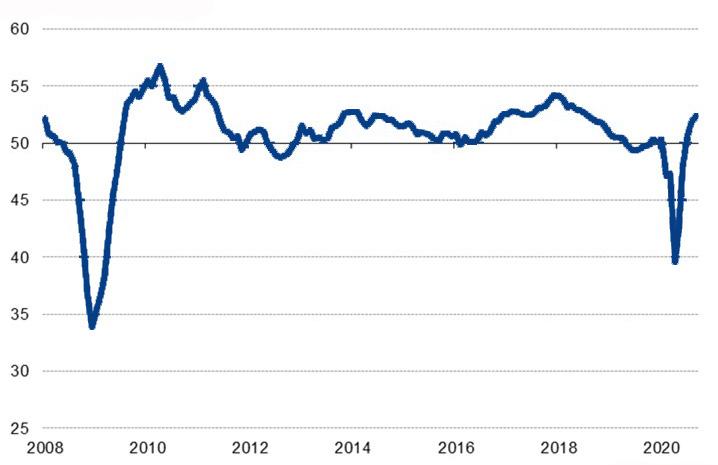
11 minute read
Navigating the Risks to
Navigating the Risks to Economic Recovery in 2021
Advertisement
Summary
The global economy is showing early signs of economic recovery in the second half of 2020, after severe lockdowns in Q2 2020 triggered deep economic contraction in the GDP of many of the world’s largest economies during the first half of 2020. The outlook for 2021 is for a year of gradual economic recovery and a return to positive economic growth for the world economy.
However new waves of Covid-19 cases in many countries in recent months are creating renewed uncertainties about the traction of economic recovery. Meanwhile governments are adopting fragmented and divergent policy approaches to tackling the pandemic. Some nations continue to impose closed borders with bans on foreigners, some have significantly reopened borders for international travel, while others have followed a more traditional epidemiological approach to managing the pandemic without severe lockdown measures.
In addition to the ongoing risks to global growth from the Covid-19 pandemic, other key risks still loom ahead in 2021, including the risk of a Hard Brexit for the UK, the policy implications of the outcome of the US elections in November 2020, and the potential further escalation of the US-China trade war.
Rajiv Biswas
Asia-Pacific Chief Economist IHS Markit
Will the World Economy Recover in 2021?
As global lockdowns have been eased since June 2020, there has been growing economic evidence of a rebound in global manufacturing output, retail sales and world trade. The JP Morgan Global Manufacturing PMI rose to a 25-month high of 52.3 in September, up from 51.8 in August. The headline PMI has signaled expansions throughout the third quarter of 2020. Out of the 29 nations for which PMI data were available, 21 registered growth during the latest survey month. New orders at their quickest pace in almost two-and-a-half years, boosted by the first increase in exports since August 2018.
Many countries have returned to positive expansion in their manufacturing sectors. The US and almost all the EU countries surveyed recorded manufacturing sector expansion during September.
The seasonally adjusted IHS Markit final U.S. Manufacturing Purchasing Managers’ Index posted 53.2 in September,
Global Manufacturing PMI
broadly in line with 53.1 seen in August. The rate of expansion was the second-fastest for almost a year, as panelists continued to note strengthening demand conditions following the marked contractions seen throughout the second quarter.
The IHS Markit Eurozone Manufacturing PMI signaled an acceleration in growth of the manufacturing economy during September. After accounting for seasonal factors, the index posted 53.7, up from 51.7 in the previous month.
September marked the strongest growth in over two years and improved operating conditions have now been signaled for three
months in a row.

In the UK, the seasonally adjusted IHS Markit/CIPS Purchasing Managers’ Index remained strong in September, at 54.1.
In the APAC region, many countries showed manufacturing expansion, including China, Australia, India and Vietnam. However, Japan and Indonesia still recorded moderate contractions in their manufacturing sectors.
China Leads APAC Recovery
The Chinese economy has been the earliest to recover from the pandemic, with recovery having gathered momentum during the second quarter of 2020. The headline seasonally
Manufacturing PMI
sa, > 50 = improvement since previous month Sep ‘20 Sources: J.P.Morgan, IHS Markit, Unicredit Bank Austria, Caixin, Davivienda, BME, HPI, AIB, Jibun Bank, NEVI, AERCE, Istanbul Chamber of Industry, CIPS adjusted Caixin China Manufacturing Purchasing Managers’ Index continued to show expansion for the fifth successive month in September, at 53.0. Notably, the latest reading rounded off the best quarterly performance since Q4 2010.
The rate of new orders for China’s manufacturing sector was the steepest recorded since the start of 2011. Stronger external demand also helped to lift sales, with new export business expanding at the quickest pace since August 2017.
China’s exports have also shown resilience despite the global recession, with total exports rising by 9.7% y/y in August 2020, helped by strong growth in exports of medical equipment, pharmaceuticals as well as electronics products.
China’s success in containing the pandemic relatively quickly has helped to support the gradual recovery of domestic consumption, with retail sales having returned close to preCovid levels by August 2020. Domestic tourism has also rebounded significantly by the time of the Golden Week holiday in early October.
A total of 97 million domestic journeys were made on the first day of the holiday, on October 1, equivalent to 74% percent of journeys made on the same day last year, according to China’s Ministry of Culture and Tourism, while tourism spending was at around 70% of the previous year’s level.

Reflecting this resilient economic performance, China is expected to be one of the only large economies that will post positive growth in 2020, albeit at a much reduced pace of around
1.7%, compared with 6% in 2019. Meanwhile other Northeast Asian economies such as South Korea have also been successful in containing their domestic Covid-19 pandemics, which has helped to boost domestic consumption spending and mitigate the impact of the global recession.
In South Asia, the Indian economy has rebounded in the third quarter of 2020 as lockdowns have been eased, despite the escalation in the daily number of new Covid-19 cases. The headline seasonally adjusted IHS Markit India Manufacturing Purchasing Managers’ Index surged higher from 52.0 in August to 56.8 in September, signaling back-to-back improvements
India Manufacturing PMI
in the health of the sector, reaching the highest level in over eight-and-a-half years.
Manufacturing output has also bounced back during the third quarter of 2020 in Southeast Asia. The Manufacturing PMI indexes for Singapore, Malaysia, Indonesia, Vietnam, Philippines and Thailand showed significant rebounds during the third quarter of 2020.
The substantial recovery in Asian industrial production and exports is reflected in the Asian electronics sector, which has rebounded as lockdowns have eased in key consumer markets like the US and EU.

The electronics manufacturing industry is an important part of the manufacturing export sector for many East Asian economies, including China, South Korea, Taiwan, Malaysia, Singapore, Philippines, Thailand and Vietnam. The Global Electronics PMI’s output index (which measures changes in production) returned to positive territory in August, reaching 50.4, signaling slight expansion. This is in comparison with severe contraction in April, as reflected in the index reading of
33.9 for that month.
sa, > 50 = improvement since previous month

Join over 3600 other industry experts in the ICISA group on LinkedIn.
Navigating the Risk Landscape for 2021
Apart from the continuing risks and uncertainties relating to the Covid-19 pandemic, a wide range of geopolitical and macroeconomic risks continue to confront the world economy in 2021. Key risks include the still uncertain outcome of the EUUK negotiations for the Brexit trade deal, the escalating USChina trade war, growing geopolitical tensions in the Eastern Mediterranean region, and the border confrontation between China and India.
The US-China Trade War: While a Phase One bilateral trade deal was agreed between the US and China in December 2019, the pandemic has derailed efforts by China to achieve the trade targets set, and bilateral trade negotiations have been continuing to try to set the trade deal back on track.
Meanwhile, the US-China technology war has also escalated significantly during 2020, with a growing number of Chinese technology firms having been placed on the US Department of Commerce “entity list”, resulting in significant restrictions on the ability of US firms to do business with these companies.
In response, China has also created its own “unreliable entity list” under new regulations which took effect in September 2020. Under the new rules, China can take measures to prohibit foreign firms listed as unreliable entities from engaging in import, export and investment in China. The potential sanctions that could be applied include:
● restricting or prohibiting the foreign entity from engaging in China-related import or export activities; ● restricting or prohibiting the foreign entity from investing in China; ● restricting or prohibiting the foreign entity’s relevant personnel or means of transportation from entering into China;
Supply Chain Vulnerabilities: The protracted disruption of industrial production in various industrial economies during the first half of 2020 has further intensified pressures on companies to diversify their supply chains to reduce vulnerability to such disruptions. Due to the large concentration of industrial production capacity in China, diversification of manufacturing production away from China has already been underway over the past decade, initially driven by rapidly rising manufacturing wage costs in coastal provinces of China. The escalating USChina trade war since 2018 has further intensified this process of supply chain diversification, as firms shifted some production of manufacturing exports for the US market away from mainland China in order to mitigate the impact of US tariff measures. The Covid-19 pandemic has become a further driver for this supply chain diversification process.

Due to the Covid-19 pandemic, governments in many countries worldwide are responding to vulnerabilities exposed in their supply chains for critical medical equipment as well as key pharmaceutical products. The disruption to production of key medical equipment in China, which is a leading global supplier of many critical products such as surgical masks, respirator masks and protective clothing, as well as surging
IHS Markit Global Electronics PMI, output and new orders
global demand, have highlighted supply chain vulnerabilities. In response, governments in some countries have taken emergency measures to establish domestic manufacturing capacity for critical equipment, as well as to create or increase domestic production facilities for essential pharmaceutical
products.
Survey index, 50 = no change on prior month


In order to help reduce supply chain vulnerabilities for Japanese firms, the Japanese government has created a Yen 23.5 billion (USD 220 million) fund in May 2020 to help Japanese companies to diversify their supply chains by increasing their production capacity by either reshoring back to Japan or shifting production to the ASEAN region. This fund was created in response to significant supply chain disruptions for Japanese firms that occurred during the extended manufacturing production shutdown in China in February as a result of the pandemic.
The first round of allocations to companies was announced in July 2020, when the Japanese government approved 57 applications by companies for financial support with supply chain diversification to reshore back to Japan, with another 30 firms receiving assistance to shift supply chains to ASEAN countries. In the second round, 1,670 applications have been made, with the government decision on which companies have been successful expected to be made in October 2020. The second round will also allow applications by firms planning to shift supply chains to India and Bangladesh to be considered for financial assistance.
US multinationals have already been diversifying their supply chains away from China over the past decade, in response to rising Chinese wage costs as well as the impact of the US punitive tariffs imposed on Chinese products during the US-China trade war. Southeast Asia has been a significant beneficiary from this supply chain diversification process, with significant diversion of US export orders away from China to Vietnam in 2019.
Brexit Risks: Over four years have passed since the UK referendum to leave the EU, and negotiations are still underway to try to find an agreement on the terms of Brexit. The risk of a “Hard Brexit” where the UK ends its transition period for leaving the EU without any deal is assessed to pose the greatest downside risks to the UK economy of the various potential exit scenarios.
With the UK economy already in recession in 2020 due to the pandemic, a “Hard Brexit” scenario could result in a protracted recession for the UK economy that extends into 2021.
Cybercrime Risks: The Covid-19 pandemic has highlighted the importance of considering low probability but high impact systemic risks that could create major economic shocks for nations, governments and companies. The accelerating pace of digital transformation worldwide during the past decade has increased the risks from cybercrime, including by criminal organizations, terrorist organizations or state-sponsored groups.
Economic Outlook for 2021
With Covid-19 vaccines expected to be deployed widely by mid-2021, the world economy is expected to return to positive growth of 4.4% year-on-year in 2021, after contracting by an estimated 4.8% y/y in 2020. The US and EU are expected to show firm positive growth during 2021. In the Asia-Pacific region, China is expected to lead the region’s economic recovery, with Chinese GDP growth forecast to be around 7% in 2021. After a severe recession in 2020, the Indian economy is also expected to rebound in 2021, growing at a pace of around 9%. Most of the major economies in the APAC region are also expected to show strong growth rebounds in 2021, boosted by buoyant growth in industrial production and exports.
However, a wide range of geopolitical and economic risks and uncertainties could derail this positive base case economic outlook for 2021. At the forefront of concerns are uncertainties about the timing of rollout of Covid-19 vaccines. If the deployment of Covid-19 vaccines becomes significantly delayed, this poses the risk of new waves of Covid-19 infections breaking out in various countries worldwide. This could significantly constrain and delay the timing and momentum of global recovery during 2021.







